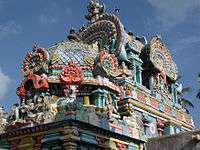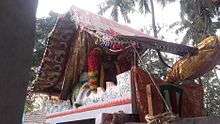Uthamar Kovil
| Sri Purushothaman Temple | |
|---|---|
|
The shine of temple seen with the temple tree, Kadhali Tree(red banana) | |
 Sri Purushothaman Temple Location in Tamil Nadu | |
| Name | |
| Other names | Uthamar Kovil |
| Proper name | Sri Purushothaman Perumal |
| Geography | |
| Coordinates | 10°29′N 78°25′E / 10.49°N 78.41°ECoordinates: 10°29′N 78°25′E / 10.49°N 78.41°E |
| Country | India |
| State/province | Tamil Nadu |
| District | Trichy |
| Locale | Tamilnadu, India |
| Culture | |
| Primary deity | Purushothaman Perumal (Vishnu) |
| Architecture | |
| Architectural styles | Dravidian architecture |
Uthamar Kovil (also known as Thirukkarambanoor or Bhikshandar Kovil) in Uthamarkoil, a village in the outskirts of Tiruchirappalli in the South Indian state of Tamil Nadu, is dedicated to the Hindu god Trimurti Vishnu, Shiva and Brahma. Constructed in the Dravidian style of architecture, the temple is glorified in the Divya Prabandha, the early medieval Tamil canon of the Azhwar saints from the 6th–9th centuries AD. It is one of the 108 Divyadesam dedicated to Vishnu, who is worshipped as Purshottamar and his consort Lakshmi as Poornavalli.
Purushottamar is believed to have appeared to Hindu gods Brahma and Shiva, to relieve Shiva off his sins committed while cutting one of Brahma's heads. The temple is one of the few historical temples in India where the images of Hindu trimurti, Vishnu, Shiva and Brahma are housed in the same premises. It is one of the two temples in Chola Nadu where the trinity can be seen in the same premises, the other being Hara Saabha Vimocchana Perumal Temple at Thirukkandiyur.
The temple is believed to have been built by the Medieval Cholas of the late 8th century AD, with later contributions from Vijayanagar kings and Madurai Nayaks. A granite wall surrounds the temple, enclosing all its shrines, while the temple tank is located outside the main gateway.
Six daily rituals and four yearly festivals are held at the temple for each of trinities. The major festival of the temple, the Brahmotsavam, is celebrated during the Tamil month of Kartigai (November – December) when festival images of both Purushotamar and Bikshadanar are carried together in the streets surrounding the temple. The temple is maintained and administered by the Hindu Religious and Endowment Board of the Government of Tamil Nadu.
Etymology and legend

Vishnu emerged as a Kadambha tree at this place, giving the name "Kathambanur", which later became "Karambanur". The name Karambanur is mentioned by Thirumangai Azhwar in Nalayira Divya Prabandam, in which he refers the presiding deity as "Karambanur Uthaman". The temple is commonly called "Uthamar Kovil" after the name of the presiding deity. The temple is also called Bhikshandar Kovil as the Hindu god Shiva is present in the form of Bhishadanar (a mendicant) and believed to have attained cure by worshiping Vishnu at this place.[1]
As per Hindu legend, once Vishnu wanted to test the devotion of Brahma. He raised as a Kadhamba tree in the place and Brahma, knowing this, started his worship practise with Thirumanjanam (ablution). The water from the ablution filled a tank nearby, which came to be known as "Kathamba Theertham". Vishnu was satisfied with the devotion of Brahma and gave a boon to Brahma to have a shrine in this place. Shiva wanted to get rid off the sin holding the cut head of Brahma and went on a sacred trip. While coming to this place, Vishnu requested his consort Lakshmi to give alms to Shiva. Shiva's grail was filled by the alms and Lakshmi came to be known as Poornavalli Thayar (the one who filled the grail).[1]
As per another legend, Brahma and Shiva both had originally five heads. Parvathi, the wife of Shiva once got confused and performed patha pooja (ablution of feet, considered an act of respect) to Brahma instead of Shiva. Shiva got enraged and cut off one of the heads of Brahma. The cut head got stuck in his hand of Shiva on account of a curse of Brahma. To get rid off the sin, Shiva worshipped Vishnu at this place as Bhikshadana, where a part of his sin was relieved. He got his curse fully relieved after visiting Vishnu at Thirukandiyur and taking a holy dip in the temple tank, Kamala Pushkarani at Hara Saabha Vimocchana Perumal Temple. After the incident, the tank came to be known as Kapala Theertham (kapala indicates skull). Shiva was pleased and he built the Hara Sabha Vimochana temple and also built a temple for himself near it.[2][3]
The temple

As per Hindu legend, the temple is believed to have been constructed by Janakar, the king of Janakapuri and the father of Sita from the epic Ramayana. Thirumangai Azhwar is believed to have resided in the temple to build the surrounding walls of the Srirangam Ranganathaswamy temple. The temple is believed to have been built by the Medieval Cholas of the late 8th century AD, with later contributions from Vijayanagar kings and Madurai Nayaks. During the war between British and French in 1751, the temple acted as an infantry for both the troops.[1]
A granite wall surrounds the temple, enclosing all its shrines. The temples has images and separate shrines for Purushottamar, Bikshadanar, Brahma and their consorts Poornavalli, Soundaraya Parvathi and Saraswathi. This is one of the few historical Hindu temple in the world, where the Hindu trimurti are worshipped with their consorts in six separate shrines within the same temple complex. The image of Vishnu in the form of Purushottamar is in reclining posture with discus in one hand, in the central shrine facing the east. The roof or vimana of the central shrine is called Udhyoga Vimana. There are two shrines located to the south east, each housing the image of Poornavalli and Mahalakshmi. The shrine of Shiva in the form of Bhikshadanar is located in the sanctum exactly behind the one of Purushottamar. The image of Bhikshadanar in the form of lingam (an iconic form of Shiva) is housed in the shrine. The granite images of the deities Ganesha (son of Shiva and god of wisdom), Murugan (son of Shiva and god of war), Nandi (the bull and vehicle of Shiva) and Navagraha (nine planetary deities) are located in the hall leading to the sanctum. As in other Shiva temples of Tamil Nadu, the first precinct or the walls around the sanctum of Bikshadanar has images of Dakshinamurthy (Shiva as the Teacher), Durga (warrior-goddess) and Chandikeswarar (a saint and devotee of Shiva). The shrines of Brahma and his consort Saraswati are located in the south west corner of the temple complex.
The Sapthaguru or seven forms of Guru at this temple are identified with the other images. The seven forms are Sadasiva Guru representing Bikshatanar, Brahma representing Brahma Guru, Soundarya Parvathy representing Sakthi Guru, Brahaspathy representing Deva Guru, Varadarajaperumal representing Vishnu Guru, Subramanyar representing Gnana Guru and Sukrachariar representing Asura Guru.[1][4][5]
Festival and administration

The temple priests perform the puja (rituals) during festivals and on a daily basis. The priests of the Bikshadanar shrine belong to the Shaiva community, while the priests of Purushothamar are from Vaishnava community. The temple rituals are performed six times a day; Ushathkalam at 5:30 a.m., Kalasanthi at 8:00 a.m., Uchikalam at 10:00 a.m., Sayarakshai at 5:00 p.m., Irandamkalam at 7:00 p.m. and Ardha Jamam at 8:30 p.m. The Saiva and Vaishnava sects have their own rituals. The ritual of Bikshadanar comprises four steps: abhisheka (sacred bath), alangaram (decoration), naivethanam (food offering) and deepa aradanai (waving of lamps) for both Bikshadanar and Soundarya Parvathi Amman. The worship is held amidst religious instructions in the Vedas (sacred texts) read by priests and prostration by worshippers in front of the temple mast. There are weekly rituals like somavaram (Monday) and sukravaram (Friday), fortnightly rituals like pradosham and monthly festivals like amavasai (new moon day), kiruthigai, pournami (full moon day) and sathurthi for Bikshadanar. The major festival of the temple, the Brahmotsavam, is celebrated during the Tamil month of Kartigai (November – December) when festival images of both Purushotamar and Bikshadanar are carried together in the streets surrounding the temple. Kadambha Thiruvizha is a festival celebrated in the temple when the festival image of Ranganthar is brought to the Kadambha tank of the temple for Theerthavari. The temple is maintained and administered by the Hindu Religious and Endowment Board of the Government of Tamil Nadu.[1]
Religious significance

Uthamar Kovil is one of the two temples in Chola Nadu where the trinity can be seen in the same premises, the other being Hara Saabha Vimocchana Perumal Temple at Thirukkandiyur. Trimurti in Hindu mythology refers to the cosmic functions of creation, maintenance, and destruction. They are personified by the forms of Brahma the creator, Vishnu the preserver, and Shiva, the destroyer.[2]
The temple is revered in Nalayira Divya Prabandham, the 7th–9th century Vaishnava canon, by Thirumangai Azhwar in ten hymns. The temple is classified as a Divyadesam, one of the 108 Vishnu temples that are mentioned in the book.[5] Thirumangai Alvar have sung in praise of the perumal in this temple with one Pasuram (hymn).[6]
| “ | பேரானைக் குறுங்குடி யெம் பெருமானைத் திருத்தண்கா
லூரானைக் கரம்பனூர் உத்தமனை முத்திங்கு காரார் திண்கடழேம் மலையேழிவ் வுகுண்டும் ஆராதென் றிந்தானைக் கண்டது தென்னரங்கத்தே |
” |
Periyavachan Pillai, who translated the verses of Thirumangai Azhwar, glorifies the temple as "the one without doors where devotees can always visit and worship".[1]
References
- 1 2 3 4 5 6 "Thirukoyil". 1. 15. Hindu Religious And Endowment Board Tamil Nadu. January 2013: 14–15. Retrieved 2013-03-17.
- 1 2 T.A., Srinivasan (21 March 2003). "Temple for the Great Trinity". The Hindu. Retrieved 2013-09-09.
- ↑ Ayyar, P. V. Jagadisa (1982). South Indian Shrines: Illustrated. New Delhi: Asian Educational Services. p. 534. ISBN 9788120601512.
- ↑ M., Balaganessin (2010-11-21). "A seat to shun ego and seek wisdom". The Hindu. Retrieved 2013-03-17.
- 1 2 "Sri Uthamar temple". Dinamalar. Retrieved 2013-03-17.
- ↑ "Thirumangai Azhwar pasuram on Uthamar Kovil". Srivaishnava.org. Retrieved 2013-03-17.
External links
| Wikimedia Commons has media related to Uthamar Kovil. |